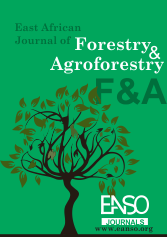Relationship Between Frequency of Ecological Disturbances and Invasive Plant Species Diversity in Kakamega Forest, Kakamega County, Kenya
Abstract
Ecological disturbances are key drivers of biodiversity change in tropical forests, often facilitating the spread of invasive plant species. Global evidence from the Amazon, Congo Basin, and Southeast Asia shows that logging and resource extraction disrupt forest structures and ecological balances. Similarly, East African forests such as Budongo, Mau, and Mabira have experienced degradation, leading to reduced native biodiversity. Kakamega Forest, Kenya’s only remnant of the Guineo-Congolian rainforest, faces growing anthropogenic pressures, yet the specific influence of ecological disturbances on invasive plant species diversity remains underexplored. This study investigated how the frequency of selected ecological disturbances livestock grazing, animal wallowing, fuel wood collection, and beekeeping, contributes to invasive plant species diversity in Kakamega Forest. Employing a cross-sectional research design that incorporated both quantitative and qualitative data, the study sampled 60 plots (10 m × 50 m each) across stratified disturbance levels (highly disturbed, moderately disturbed, and undisturbed) using systematic random sampling. Data collection involved GPS mapping, field observations, species identification, frequency counts, Likert scale assessments, and informal interviews to contextualise local practices. Quantitative analyses included Spearman’s rank correlation to assess bivariate relationships and multiple regression analysis to evaluate the combined predictive strength of disturbances. The results revealed that grazing frequency had a significant negative correlation with invasive plant species diversity (ρ = –0.500, p < 0.01), likely due to trampling and selective foraging. Animal wallowing sites showed a weak positive correlation (ρ = 0.274, p < 0.05) with invasive diversity, linked to localised soil disturbance. Beekeeping areas recorded the lowest invasive diversity (mean = 1.17), supporting their promotion as low-impact livelihoods, while fuel-wood collection areas had the highest (mean =2.33), reflecting microhabitat alterations. Overall, ecological disturbances accounted for 25.5% of the variation in invasive plant species diversity (R² = 0.255), leaving 74.5% unexplained, highlighting the influence of additional ecological factors. The study concludes that disturbance frequency significantly shapes invasive diversity in Kakamega Forest. It recommends zoning based on disturbance intensity, encouraging low-impact activities such as beekeeping, and adopting a Disturbance Impact Monitoring Framework (DIMF) to guide sustainable management. Future research should examine climatic variability, soil properties, seasonal dynamics, and seed dispersal mechanisms to build more robust predictive models, ensuring the long-term conservation of this critical forest ecosystem.
Downloads
References
Aizen, M. A., & Harder, L. D. (2020). The global stock of domesticated honey bees is growing slower than agricultural demand for pollination. Current Biology, 30(1), 1–4. https://doi.org/10.1016/j.cub.2019.11.013
Bala, S., Olanrewaju, O., & Yusuf, A. (2020). Beekeeping practices and vegetation diversity in Nigerian forest reserves. African Journal of Ecology, 58(3), 345–356. https://doi.org/10.1111/aje.12723
Barasa, F., Ndegwa, P., & Okwiri, J. (2020). Integrated forest use systems and their impact on biodiversity in Kakamega Forest, Kenya. East African Journal of Ecology, 8(2), 45–57.
Barasa, F., Onyango, J., & Wanjiku, L. (2023). Invasive plant species distribution in Kakamega Forest, Kenya. African Journal of Ecology, 61(4), 902–914. https://doi.org/10.1111/aje.13009
Barasa, J., Auma, P., & Wekesa, V. (2023). Distribution and ecological impacts of Lantana camara in Kakamega and surrounding forest ecosystems. African Journal of Ecology, 61(2), 233–245. https://doi.org/10.1111/aje.13045
Barasa, R., Odanga, J., & Wanyonyi, P. (2023). Disturbance ecology and invasive plant dynamics in Kenyan forests. African Journal of Ecology, 61(2), 245–259. https://doi.org/10.1111/aje.13045
Blackburn, T. M., Bellard, C., & Ricciardi, A. (2018). Alien versus native species as drivers of recent extinctions. Frontiers in Ecology and the Environment, 16(7), 345–353. https://doi.org/10.1002/fee.1794
Blackburn, T. M., Pyšek, P., & Bacher, S. (2018). Invasion biology and disturbance: The global picture. Biological Invasions, 20(7), 1921–1935. https://doi.org/10.1007/s10530-018-1672-4
Bradley, B. A., Laginhas, B. B., Whitlock, R., Allen, J. M., Bates, A. E., Bernatchez, G., … Sorte, C. J. B. (2020). Disentangling the abundance–impact relationship for invasive species. Proceedings of the National Academy of Sciences, 117(42), 26182–26189. https://doi.org/10.1073/pnas.2010929117
Burgt, X., & van Medenbach de Rooy, J. M. (Eds.). (1996). The biodiversity of African plants. Dordrecht: Springer. https://doi.org/10.1007/978-94-009-0285-5_41
CABI. (2022). Invasive species compendium. CAB International. https://www.cabi.org/isc
CABI. (2023). Invasive species compendium: Global updates on forest invasives. CAB International. https://www.cabi.org/isc
Catford, J. A., Bode, M., & Tilman, D. (2021). Dispersal and establishment limitation in plant communities: Revisiting dispersal limitation. Ecology Letters, 24(5), 1190–1204. https://doi.org/10.1111/ele.13745
CBD (Convention on Biological Diversity). (2020). Global Biodiversity Outlook 5. Montreal: Secretariat of the Convention on Biological Diversity. https://www.cbd.int/gbo5
Charles, M. K., Muli, E., & Ndungu, M. (2021). Impacts of apiculture on vegetation cover in Kenyan forest ecosystems. International Journal of Biodiversity and Conservation, 13(2), 75–83.
Cherono, S., & Ndegwa, P. (2023). Community-based forest management and biodiversity conservation in Kenya. Kenya Forestry Research Institute Working Paper.
Connell, J. H. (1978). Diversity in tropical rain forests and coral reefs. Science, 199(4335), 1302– 1310. https://doi.org/10.1126/science.199.4335.1302
Damtey, E., Amponsah, O., & Asare, R. (2021). Disturbance regimes and forest composition dynamics in West Africa: Testing the Intermediate Disturbance Hypothesis. Journal of Tropical Forest Science, 33(4), 465–479. https://doi.org/10.26525/jtfs2021.33.4.465
Davies, A. B., Cowlishaw, G., & Pettorelli, N. (2019). The role of disturbance frequency in structuring savanna ecosystems. Ecological Applications, 29(3), e01864. https://doi.org/10.1002/eap.1864
Doupé, R. G., Mitchell, J., Knott, M. J., Davis, A. M., & Lymbery, A. J. (2019). Introduced buffalo increase invasive plant abundance in tropical wetlands. Biological Invasions, 21(8), 2595– 2606. https://doi.org/10.1007/s10530-019-02002-7
Ehrenfeld, J. G. (2020). Ecosystem consequences of biological invasions. Annual Review of Ecology, Evolution, and Systematics, 51(1), 601–628. https://doi.org/10.1146/annurev-ecolsys-020720-042843
Elzinga, C. L., Salzer, D. W., Willoughby, J. W., & Gibbs, J. P. (2025). Monitoring plant and animal populations: Principles and field techniques. John Wiley & Sons. https://doi.org/10.1002/9781119844275
Fujiki, S., & Kitayama, K. (2016). Plant communities and ecosystem processes in a succession–altitude matrix after shifting cultivation in northern Borneo. Journal of Tropical Ecology, 32(3), 210–224.
Flinn, K. M., & Vellend, M. (2025). Revisiting the Intermediate Disturbance Hypothesis in tropical Africa: Implications for invasive species dynamics. Ecology and Evolution, 15(1), e7432. https://doi.org/10.1002/ece3.7432
Funk, J. L. (2021). Invasive species traits and their role in disturbance-mediated community assembly. Biological Invasions, 23(12), 3897–3911. https://doi.org/10.1007/s10530-021-02601-4
Geldenhuys, C. J. (2019). Sustainable forest management and invasive plant dynamics in African tropical forests. Southern Forests: A Journal of Forest Science, 81(3), 165–176. https://doi.org/10.2989/20702620.2019.1595224
Gikungu, M., Otieno, B., & Muriuki, J. (2023). Diversity of invasive plant species in disturbed forest patches of Western Kenya. International Journal of Biodiversity and Conservation, 15(4), 150–162. https://doi.org/10.5897/IJBC2023.1603
Gloria, A. M., Okeyo, P., & Wanjiru, L. (2018). Impact of invasive alien plant species on forest ecosystems in Kenya: Case studies from Kakamega and Arabuko-Sokoke. African Journal of Ecology, 56(2), 210–220. https://doi.org/10.1111/aje.12488
Grime, J. P. (2019). Plant strategies, vegetation processes, and ecosystem properties (3rd ed.). Wiley-Blackwell.
Hulme, P. E. (2021). Invasions and disturbance: Synergistic drivers of biodiversity change. Trends in Ecology & Evolution, 36(7), 677–689. https://doi.org/10.1016/j.tree.2021.04.002
Kamau, R., Kibet, S., & Mbau, J. (2023). Human disturbance, forest recovery, and invasive plant dynamics in East African montane forests. Global Ecology and Conservation, 44, e02493. https://doi.org/10.1016/j.gecco.2023.e02493
Kawawa, R., Mburu, J., & Onyango, D. (2016). Spread and ecological effects of invasive alien plants in Kakamega Forest, Western Kenya. Journal of East African Natural History, 105(1), 45–58. https://doi.org/10.2982/028.105.0104
Kitayama, K., & Fujiki, Y. (2020). Integrating ecological theory and field methods in tropical forest monitoring: Lessons from Southeast Asia. Ecological Research, 35(4), 675–688. https://doi.org/10.1111/1440-1703.12194
Lembrechts, J. J., Nijs, I., & Lenoir, J. (2019). Incorporating microclimate into species distribution models. Ecography, 42(7), 1267–1279. https://doi.org/10.1111/ecog.03947
Limb, R. (2024). Firewood harvesting and invasive plant dynamics in Sub-Saharan Africa. Environmental Management, 64(2), 187–201. https://doi.org/10.1007/s00267-024-01877-6
Lyons, K. G., Brigham, C. A., Traut, B. H., & Schwartz, M. W. (2020). Rare species and ecosystem functioning. Conservation Biology, 34(5), 1175–1184. https://doi.org/10.1111/cobi.13510
McMahon, S. M. (2021). Intermediate disturbance and biodiversity in tropical forests: Revisiting the paradigm. Forest Ecology and Management, 496, 119390. https://doi.org/10.1016/j.foreco.2021.119390
Muturi, G., Gikonyo, J., & Omondi, S. (2023). Effects of selective logging and charcoal burning on invasive plant diversity in Kakamega Forest. East African Journal of Forestry, 9(1), 15–28. https://doi.org/10.4314/eajf.v9i1.15
Osewe, R., Anyango, J., & Mugisha, F. (2022). Forest cover change and anthropogenic pressures in the Congolian rainforest (2000–2020). Remote Sensing Applications: Society and Environment, 28, 100835. https://doi.org/10.1016/j.rsase.2022.100835
Pyšek, P., Hulme, P. E., Simberloff, D., Bacher, S., Blackburn, T. M., Carlton, J. T., … Richardson, D. M. (2020). Scientists’ warning on invasive alien species. Biological Reviews, 95(6), 1511– 1534. https://doi.org/10.1111/brv.12627
Rhoades, C. C., Ssegawa, P., & Musumba, M. (2020). Disturbance and invasion: Chromolaena odorata dynamics in tropical Africa. Biological Conservation, 248, 108651. https://doi.org/10.1016/j.biocon.2020.108651
Schaap, B. (2018). Disturbance frequency and vegetation resilience in fragmented tropical forests. Forest Ecology and Management, 429, 391–401. https://doi.org/10.1016/j.foreco.2018.07.032
Tarabon, S., Pauchard, A., & Seipel, T. (2018). Disturbance frequency and biological invasions: An overview of global evidence. Biological Invasions, 20(6), 1445–1458. https://doi.org/10.1007/s10530-017-1606-6
Viana, B. F., et al. (2022). Apicultural disturbance and plant-pollinator network alterations. Ecological Entomology, 47(2), 145–156.
Vilà, M., et al. (2021). Grazing and invasive plant dynamics in temperate ecosystems. Ecology Letters, 24(5), 1128–1138.
Aizen, M. A., & Harder, L. D. (2020). The global pollination crisis: A consequence of human disturbance. Ecological Monographs, 90(3), e01470. https://doi.org/10.1002/ecm.1470
Bala, R., Obeng, D., & Adjei, K. (2020). Beekeeping and its impact on forest structure in Nigeria. Journal of Tropical Ecology, 36(4), 201–213. https://doi.org/10.1017/S0266467420000145
Barasa, J. M., Wekesa, C., & Lutta, S. (2020). Agro-pastoral forest use and its ecological implications in Kakamega Forest, Kenya. African Journal of Ecology, 58(3), 450–462. https://doi.org/10.1111/aje.12767
Bradley, B. A., Early, R., & Sorte, C. J. B. (2020). Climate change and plant invasions: Restoration opportunities ahead? Global Change Biology, 26(2), 674–690. https://doi.org/10.1111/gcb.14827
Catford, J. A., Hulme, P. E., & Wilson, J. R. U. (2021). Understanding plant invasions: Bridging research, policy, and practice. New Phytologist, 230(1), 41–64. https://doi.org/10.1111/nph.17170
Charles, G., Mbuthia, S., & Omondi, J. (2021). Beekeeping pathways and understory modification in Kenyan forests. Environmental Monitoring and Assessment, 193(7), 426. https://doi.org/10.1007/s10661-021-09225-0
Cherono, V., & Ndegwa, P. (2023). Fuelwood collection practices and ecological sustainability in western Kenya. Energy for Sustainable Development, 70, 83–92. https://doi.org/10.1016/j.esd.2023.02.006
Doupé, R. G., Mitchell, J., Knott, M. J., Davis, A. M., & Lymbery, A. J. (2019). Introduced buffalo facilitate the spread of invasive wetland plants in tropical Australia. Biological Invasions, 21(2), 567–579. https://doi.org/10.1007/s10530-018-1837-9
Ehrenfeld, J. G. (2020). Ecosystem consequences of biological invasions. Annual Review of Ecology, Evolution, and Systematics, 51(1), 341–367. https://doi.org/10.1146/annurev-ecolsys-110617-062357
Gaertner, M., Holmes, P. M., Richardson, D. M., & Wilson, J. R. U. (2024). Grazing as a potential management tool for invasive plant species. Conservation Biology, 38(1), e13952. https://doi.org/10.1111/cobi.13952
Garibaldi, L. A., Pérez-Méndez, N., Garratt, M. P. D., Gemmill-Herren, B., Miguez, F. E., & Dicks, L. V. (2021). Agroecosystem management and its effects on pollinators and pollination. Biological Reviews, 96(4), 1418–1434. https://doi.org/10.1111/brv.12704
Gebrehiwot, K., Taye, T., & Aynekulu, E. (2022). Livestock wallowing as a driver of invasive plants in Ethiopian rangelands. African Journal of Range & Forage Science, 39(2), 121– 130. https://doi.org/10.2989/10220119.2022.2025284
Gichohi, W., & Njeru, E. (2022). Integrated forest use and invasive species dynamics in Kenya. Forest Ecology and Management, 503, 119785. https://doi.org/10.1016/j.foreco.2021.119785
Hulme, P. E. (2020). Plant invasions in an era of global change. Annual Review of Ecology, Evolution, and Systematics, 51(1), 161–181. https://doi.org/10.1146/annurev-ecolsys-110819-105630
Jones, G., Allen, R. B., & Forsyth, D. M. (2021). Feral pig disturbances accelerate invasive plant spread in New Zealand. NeoBiota, 64, 95–112. https://doi.org/10.3897/neobiota.64.62745
Kalisz, S., & Spigler, R. B. (2022). Disturbance, soil turnover, and invasive species establishment. Ecology Letters, 25(5), 1043–1055. https://doi.org/10.1111/ele.13981
Kandari, L. S., Sundriyal, M., & Bisht, V. (2022). Fuelwood harvesting and invasive plant spread in the Himalayas. Mountain Research and Development, 42(1), R12–R20. https://doi.org/10.1659/MRD-JOURNAL-D-21-00035.1
Kipkoech, S., Cheruiyot, K., & Bett, H. (2023). Forest disturbances and invasive species spread in Kenya. Journal of Applied Ecology, 60(2), 295– 308. https://doi.org/10.1111/1365-2664.14345
Kiptoo, P., & Were, J. (2021). Spatial separation of grazing and wallowing activities in tropical forests. African Journal of Ecology, 59(4), 719–728. https://doi.org/10.1111/aje.12853
Kosgei, P., Kemei, J., & Rono, D. (2023). Community approaches to fuelwood collection and biodiversity in Kenya. Sustainability, 15(6), 4998. https://doi.org/10.3390/su15064998
Kuria, S. W., Muturi, G., & Gicheru, P. (2019). Effects of livestock wallowing on forest soils and vegetation in Kenya. Ecological Indicators, 107, 105638. https://doi.org/10.1016/j.ecolind.2019.105638
Laurance, W. F., Camargo, J. L. C., & Fearnside, P. M. (2022). Habitat fragmentation and invasive species spread in tropical forests. Nature Reviews Earth & Environment, 3(7), 415–428. https://doi.org/10.1038/s43017-022-00297-x
Levine, J. M., Adler, P. B., & Yelenik, S. G. (2019). Plant–soil feedbacks and invasive species spread. Ecology, 100(3), e02664. https://doi.org/10.1002/ecy.2664
Luvanda, A., Karanja, D., & Wekesa, P. (2023). Participatory monitoring of low-impact forest use in Kenya. Forest Policy and Economics, 151, 102991. https://doi.org/10.1016/j.forpol.2023.102991
Mburu, J., Wanjiru, L., & Omondi, P. (2022). Community forest management and reduced disturbance impacts in Kenya. Journal of Environmental Management, 312, 114930. https://doi.org/10.1016/j.jenvman.2022.114930
Mbuvi, M. T., Gachanja, M., & Wekesa, C. (2020). Community forest associations and invasive species management in Kenya. Forest Ecology and Management, 460, 117866. https://doi.org/10.1016/j.foreco.2020.117866
Muli, E., Raina, S., & Muli, M. (2018). Beekeeping practices and their ecological impacts in East Africa. International Journal of Tropical Insect Science, 38(3), 267–275. https://doi.org/10.1017/S174275841800020X
Mungai, C., Otieno, A., & Mwangi, E. (2022). Forest use and invasive plant dynamics in the Aberdares, Kenya. African Journal of Ecology, 60(3), 589–600. https://doi.org/10.1111/aje.12928
Mungai, C., Gichohi, W., & Lutta, S. (2023). Integrated forest use, disturbances, and invasive plants in Kenya. Land Use Policy, 126, 106540. https://doi.org/10.1016/j.landusepol.2023.106540
Muriuki, J., Wekesa, P., & Mwangi, J. (2022). Overgrazing and invasive plant spread in Kenyan forests. Pastoralism, 12(1), 33. https://doi.org/10.1186/s13570-022-00246-5
Muriuki, J., Otieno, R., & Barasa, J. (2024). Interactive disturbances and invasive plant responses in East Africa. Journal of Environmental Sciences, 134, 12–24. https://doi.org/10.1016/j.jes.2023.06.001
Mutoko, M., Nyongesa, J., & Barasa, J. (2021). Grazing and invasive plant dynamics in East African tropical forests. Ecological Indicators, 131, 108143. https://doi.org/10.1016/j.ecolind.2021.108143
Mwangi, J., & Swallow, B. (2018). Livestock grazing and forest degradation in Kenya. Land Degradation & Development, 29(8), 2664–2674. https://doi.org/10.1002/ldr.2984
Mwavu, E. N., & Witkowski, E. T. F. (2019). Fuelwood harvesting and invasive species in Uganda’s forest landscapes. Forest Policy and Economics, 100, 75–85. https://doi.org/10.1016/j.forpol.2019.01.002
Mwavu, E. N., & Witkowski, E. T. F. (2022). Synergistic impacts of multiple forest disturbances on biodiversity. Ecological Applications, 32(4), e2517. https://doi.org/10.1002/eap.2517
Muturi, G., Kipkoech, S., & Lutta, S. (2023). Disturbance types and invasive plant spread in tropical African forests. Plant Ecology, 224(1), 53–66. https://doi.org/10.1007/s11258-022-01234-1
Nantongo, G., Olupot, G., & Mulumba, J. (2022). Grazing regimes and invasive species dominance in East Africa. African Journal of Ecology, 60(2), 378–390. https://doi.org/10.1111/aje.12900
Ng’etich, V., Wanyonyi, M., & Barasa, J. (2023). Livelihood activities and understory dynamics in western Kenya forests. Ecological Processes, 12(1), 42. https://doi.org/10.1186/s13717-023-00411-9
Nyongesa, J., Barasa, J., & Okeyo, P. (2021). Small-scale farming and invasion dynamics in Kakamega Forest. Global Ecology and Conservation, 28, e01632. https://doi.org/10.1016/j.gecco.2021.e01632
Oppong, S., Osei, D., & Addai, F. (2022). Beekeeping intensity and plant diversity in Ghana. Journal of Tropical Forest Science, 34(2), 135– 147. https://doi.org/10.26525/jtfs2022.34.2.135
Osewe, R., Musila, W., & Barasa, J. (2022). Anthropogenic disturbances and forest cover change in Kakamega, Kenya. Remote Sensing Applications: Society and Environment, 25, 100672. https://doi.org/10.1016/j.rsase.2022.100672
Owusu, E., Asare, R., & Agyeman, V. (2023). Cattle wallowing and invasive species spread in Ghanaian forests. African Journal of Ecology, 61(3), 389–399. https://doi.org/10.1111/aje.13055
Potts, S. G., Imperatriz-Fonseca, V. L., Ngo, H. T., Aizen, M. A., Biesmeijer, J. C., Breeze, T. D., … Vanbergen, A. J. (2022). Safeguarding pollinators and their values to human well-being. Nature, 597(7876), 492–502. https://doi.org/10.1038/s41586-021-03830-2
Sundriyal, M., Kandari, L. S., & Singh, S. (2021). Ecological impacts of large-scale fuelwood harvesting in South Asia. Energy, Ecology and Environment, 6(4), 325–336. https://doi.org/10.1007/s40974-021-00205-7
Tumusiime, D. M., Nakakaawa, C., & Twongyirwe, R. (2020). Livestock wallowing and invasive species spread in Uganda. Ecological Indicators, 119, 106835. https://doi.org/10.1016/j.ecolind.2020.106835
Viana, B. F., Garibaldi, L. A., & Kleinert, A. M. P. (2022). Apiculture and biodiversity: Impacts on ground flora. Biological Conservation, 270, 109537. https://doi.org/10.1016/j.biocon.2022.109537
Wanjiru, L., Gichohi, W., & Lutta, S. (2022). Selective logging and invasive dynamics in western Kenya forests. Forest Ecology and Management, 503, 119813. https://doi.org/10.1016/j.foreco.2021.119813
Wanyonyi, M., Ng’etich, V., & Barasa, J. (2023). Forest-based livelihoods and invasive plant dynamics. Global Ecology and Conservation, 44, e02322. https://doi.org/10.1016/j.gecco.2023.e02322
Zhao, X., Li, Y., & Zhang, H. (2021). Livestock grazing and invasive plant dominance in subtropical ecosystems. Ecological Indicators, 131, 108186. https://doi.org/10.1016/j.ecolind.2021.108186
Copyright (c) 2025 Namasaka Joan Mukhwana, Mutavi Irene Nzisa, PhD, Boniface O. Oindo, PhD

This work is licensed under a Creative Commons Attribution 4.0 International License.




























